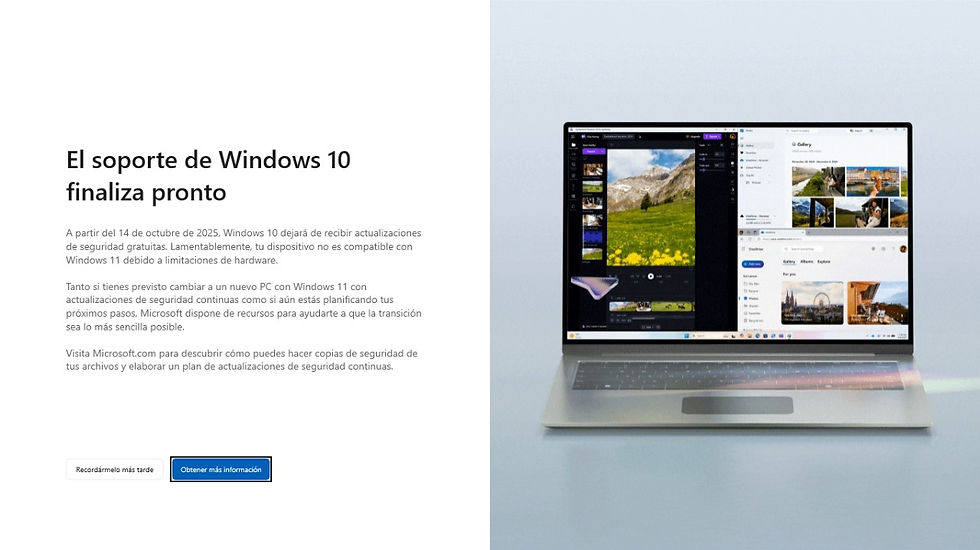Windows 10 is coming to an end: Microsoft is already warning you on your screen.
- Digital Arias
- Aug 31
- 2 min read

Date: August 31, 2025
Author: Mauricio Arias – Chairman of the Board, Digital Arias
On October 14, 2025, Windows 10 will no longer receive official support from Microsoft. The warning is already appearing on many users' screens: after that date, there will be no more security updates or improvements.
This isn't a technical detail: it's a clear message for entrepreneurs and organizations. If your business still relies on Windows 10, the continuity of your operations and the security of your data could be at risk.
What does this warning mean?
Microsoft has started displaying messages on Windows 10 computers that don't meet the requirements to upgrade to Windows 11. The critical point is that many computers, especially older ones, won't be able to migrate due to hardware limitations.
In simple terms:
- Deadline: October 14, 2025.
- Consequence: There will be no more free security updates.
- Main problem: Many current computers do not meet Windows 11 requirements (such as the TPM 2.0 chip).
Trying to force the installation of Windows 11 is not recommended. The safest option is to plan a technological upgrade in advance.
Why did Microsoft make this decision?
Far from being a whim, this change responds to three fundamental reasons:
1. Modern security: Windows 11 integrates technologies that make it much more difficult for a cyberattack to affect your information.
2. Better performance: It is designed to take advantage of current hardware, which means greater efficiency and productivity.
3. Continuous innovation: Microsoft focuses its efforts on a single operating system to advance faster and offer greater stability.
What happens if I continue using Windows 10 after 2025?
Ignoring the warning can be very costly:
- Increased risk of cyberattacks: Every vulnerability will be an open door.
- Software incompatibility: Many applications will stop working properly.
- Possible legal sanctions: Working with unsupported systems can violate data protection regulations.
- Loss of productivity: More failures and downtime in your daily operations.
What should your company do?
The key is to plan now, not wait until the last minute. These are the recommended steps:
1. Assess your current situation: Identify which devices can be upgraded and which must be renewed.
2. Define a budget: Include migration in your 2025 financial planning.
3. Back up your data: Backups are always the first security measure.
4. Seek expert advice: Avoid improvisation; a poorly executed migration can bring your business to a standstill.
Upgrading is not an expense, it's an investment.
Upgrading to Windows 11 and upgrading devices when necessary isn't just about "having the latest." It's about protecting your business information, ensuring operational continuity, and maintaining your competitive advantage.
At Digital Arias, we understand what this change means for businesses and organizations. We help you review your technology infrastructure, plan your migration, and execute a frictionless and risk-free transition.
Conclusion
The end of Windows 10 marks the end of an era and the beginning of a more secure, productive, and future-proof one.
👉 Don't wait until October 14, 2025. Start preparing for the change today. At Digital Arias, we are ready to advise you and ensure that your company continues to operate with the best technology available.








Comments